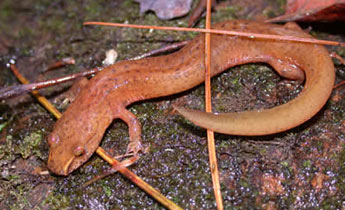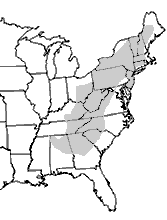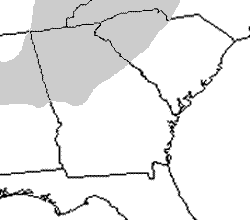Spring Salamander (Gyrinophilus porphyriticus)



Photos by J.D. Willson unless otherwise noted
| Description: Spring salamanders are one of the largest stream salamanders in our region (5 – 7.5 in; 12 – 19 cm). They have a fairly slender build and a light-colored ridge running from the eye to the tip of the snout. Coloration varies from salmon to yellowish brown with hints of red, and quite often there is a mottled or cloudy appearance with small dark spots. The venter is pale pink with small black spots on the belly and throat. This species’ elongate build and nasal ridge distinguish it from the similar mud and red salamanders (Pseudotriton sp.)
Range and Habitat: Spring Salamanders throughout the Appalachian Mountains and northeastern U.S. In our region they are restricted to mountainous areas of northern Georgia and northwestern South Carolina. This species is found in and around clear, cool mountain springs, creeks, and seeps. They are occasionally found fairly far from water in moist forests. Habits: Spring Salamanders are most frequently encountered under rocks, logs, and other cover objects near streams or seeps. Although they take cover under such objects by day they are active at night when they search for invertebrate and small vertebrate prey. In some regions the bulk of Spring Salamander diets consist of other salamanders. Adults are frequently found crossing roads on rainy nights. Breeding occurs during the fall and spring and females lay up to 100 eggs in the summer. Relatively few spring salamander nests have been found suggesting that this species often lays its eggs in underground sections of streams. Larvae are aquatic and have one of the longest larval periods of any salamander in our region, lasting 3 – 4 years. Consequently, larvae are very large at metamorphosis, nearly reaching adult size. Larvae of this species can be very difficult to differentiate from those of mud and red salamander (Pseudotriton sp.) Conservation Status: The Spring Salamander is not protected in Georgia and is common in its preferred habitat, but alteration of stream habitat, particularly sedimentation, has had detrimental effects on the habitat of this salamander. Pertinent Reference: Account Author: Matt Slafkosky, University of Georgia – revised by J.D. Willson |
